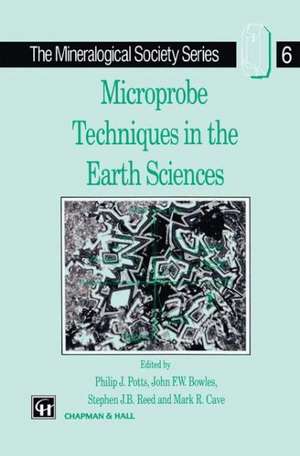Microprobe Techniques in the Earth Sciences: The Mineralogical Society Series, cartea 6
Editat de Philip J. Potts, J.F. Bowles, Stephen.J. Reed, R. Caveen Limba Engleză Paperback – 31 dec 1995
This text covers the range of microanalytical techniques available for the analysis of geological samples, principally in research applications. Each chapter is written in a clear, informative style and has a tutorial element, designed to introduce each technique for the beginning and experienced researcher alike.
Preț: 950.21 lei
Preț vechi: 1158.79 lei
-18% Nou
Puncte Express: 1425
Preț estimativ în valută:
181.82€ • 189.83$ • 150.48£
181.82€ • 189.83$ • 150.48£
Carte tipărită la comandă
Livrare economică 04-18 aprilie
Preluare comenzi: 021 569.72.76
Specificații
ISBN-13: 9780412551000
ISBN-10: 0412551004
Pagini: 419
Ilustrații: XII, 419 p. 47 illus.
Dimensiuni: 155 x 235 x 23 mm
Greutate: 0.58 kg
Ediția:1995
Editura: Springer Us
Colecția Springer
Seria The Mineralogical Society Series
Locul publicării:New York, NY, United States
ISBN-10: 0412551004
Pagini: 419
Ilustrații: XII, 419 p. 47 illus.
Dimensiuni: 155 x 235 x 23 mm
Greutate: 0.58 kg
Ediția:1995
Editura: Springer Us
Colecția Springer
Seria The Mineralogical Society Series
Locul publicării:New York, NY, United States
Public țintă
ResearchCuprins
1 Microanalysis from 1950 to the 1990s.- 1.1 Introduction.- 1.2 Microscope methods with image-plane selection.- 1.3 Microprobe methods.- 1.4 The possibilities: primary and secondary beams.- 1.5 Some history.- 1.6 Quantitative analysis.- 1.7 Precision, accuracy and resolution.- 1.8 Other techniques using electrons and/or X-rays.- 1.9 Selected-area mass spectrometry with direct excitation.- 1.10 Selected-area mass spectrometry with indirect excitation.- 1.11 Laser heating.- 1.12 Detection of molecular species.- 1.13 Which technique? Analytical strategy and tactics.- References.- 2 Electron microprobe microanalysis.- 2.1 Introduction.- 2.2 X-ray spectroscopy.- 2.3 Wavelength-dispersive spectrometers.- 2.4 Energy-dispersive spectrometers.- 2.5 The electron column.- 2.6 Scanning and mapping.- 2.7 Qualitative analysis.- 2.8 Quantitative analysis — experimental.- 2.9 Quantitative analysis — data reduction.- References.- Further reading.- 3 Analytical electron microscopy.- 3.1 Introduction.- 3.2 The X-ray analysis of thin specimens.- 3.3 Electron energy-loss spectroscopy.- 3.4 EDS versus EELS.- 3.5 Future directions of AEM instrumentation.- Acknowledgements.- References.- he nuclear microprobe — PIXE, PIGE, RBS, NRA and 141 ERDA.- 4.1 Introduction.- 4.2 The proton microprobe.- 4.3 The PIXE technique.- 4.4 Geological applications of PIXE.- 4.5 Nuclear reaction analysis (NRA) and PIGE.- 4.6 Rutherford backscattering (RBS).- 4.7 Elastic recoil detection analysis (ERDA).- 4.8 Conclusions.- Acknowledgements.- References.- 5 Synchrotron X-ray microanalysis.- 5.1 Introduction.- 5.2 Synchrotron storage rings.- 5.3 Beamline and experimental stations.- 5.4 Specimen preparation.- 5.5 Analysis.- 5.6 Illustrative applications and future advances.- Acknowledgements.- Invitation.-Appendix 5A Notation and abbreviations.- References.- Further reading.- 6 Ion microprobe analysis in geology.- 6.1 Introduction.- 6.2 Instrumentation.- 6.3 Secondary ion production.- 6.4 Analytical procedures.- 6.5 Applications: elemental analysis.- 6.6 Applications: isotopic analysis.- 6.7 Future developments.- Acknowledgements.- References.- 7 Mineral microanalysis by laserprobe inductively coupled plasma mass spectrometry.- 7.1 Introduction.- 7.2 Inductively coupled plasma mass spectrometry.- 7.3 Laser ablation and ICP-MS.- 7.4 Analytical rationale.- 7.5 History of laser ablation analysis.- 7.6 Bulk sampling with LA-ICP-MS: an alternative to solution preparation.- 7.7 Analytical methodology.- 7.8 Detection limits.- 7.9 Applications.- 7.10 Future trends.- 7.11 Conclusions.- References.- 8 Ar-Ar dating by laser microprobe.- 8.1 Introduction.- 8.2 The 40Ar-39Ar dating technique.- 8.3 Estimation of errors.- 8.4 Instrumentation.- 8.5 Methodology.- 8.6 Applications of the laser microprobe technique.- References.- 9 Stable isotope ratio measurement using a laser microprobe.- 9.1 Introduction.- 9.2 Stable isotope geochemistry.- 9.3 Conventional preparation of gases for stable isotope studies.- 9.4 Stable isotope ratio mass spectrometry.- 9.5 Historical development of the laser microprobe.- 9.6 Application of the laser microprobe to stable isotope studies.- 9.7 Instrumentation.- 9.8 Carbon and oxygen isotopic analyses of carbonates.- 9.9 Sulphur isotopic measurements of sulphides.- 9.10 Oxygen isotopic analyses of silicates and oxides.- 9.11 Nitrogen isotope analyses.- 9.12 Conclusions.- 382 Acknowledgements.- References.- 10 Micro-Raman spectroscopy in the Earth Sciences.- 10.1 Introduction.- 10.2 Principles.- 10.3 Instrumentation.- 10.4 Sample handling and routine operation.- 10.5 Advantages and disadvantages of the Raman technique.- 10.6 Some applications of micro-Raman spectroscopy in the Earth Sciences.- 10.7 Other applications of micro-Raman spectroscopy in the Earth Sciences.- 10.8 Other Raman techniques and closing remarks.- Acknowledgements.- References.
Recenzii
...an invaluable research reference and a much needed text for final year undergraduates. - Aslib Book Guide
















